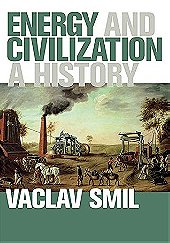“Despite many differences in agronomic practices and in cultivated crops, all traditional agricultures shared the same energetic foundation. They were powered by the photosynthetic conversion of solar radiation, producing food for people, feed for animals, recycled wastes for the replenishment of soil fertility, and fuels for smelting the metals needed to make simple farm tools. Consequently, traditional farming was, in principle, fully renewable.”
Vaclav Smil's Energy and Civilization: A History book gives us a walkthrough history (Yes here we go again!) outlining how humans have managed and obtained energy beginning with pre-agricultural foraging societies working all the way to present day fossil fuel-driven civilization.
I will list the chapters to give any potential reader a precise feel and guide to what to expect as well in this rather informative book, giving Smil's pensive perspective with extensive research:
*1: Energy and Society
*2: Energy in Prehistory
*3: Traditional Farming
*4: Preindustrial Prime Movers and Fuels
*5: Fossil Fuels, Primary Electricity, and Renewables
*6: Fossil-Fueled Civilization
*7: Energy in World History
The first and second chapter detailed foraging societies, various processes and systems accompanying hunter-gatherer groups while heading towards the origins of agriculture.
While the third part deals with examples such as cropping cycles, irrigation, fertilization and crop Diversity. Smil certainly teaches the reader about the various dynamics behind cultivation farming and the amount of knowledge as well as practical work that comes with it. We have a look at Ancient Egypt, China, Mesoamerica Cultures, Europe, and North America. It gives the reader a taste of how these ancient civilisations regarding how agriculture garnered advanced techniques to feed and nourish their populaces.
The fourth chapter was again a flourish of information regarding wind power, hydropower, biomass fuels, wood and charcoal, transportation and construction, buildings and structures, metallurgy, warfare, explosives and guns, heat and light... And so on and so forth.
The fifth mainly gives us the industrial revolution with aspects such as coal extraction, steam engines, oil and electricity, renewable energies and various technical innovations.
Overall, Energy and Civilisation: A History is another book which gives us a very educational and detailed examination which correlates the progress of civilisations with energies obtained and the various stages we have seen in most civilisations, past and present, up to the current stage/level we find ourselves at. The later chapters also provide insight into economic growth, quality of life, weapons and war, environmental changes, patterns of energy use, imperatives of energy needs and uses and looking at aspects that haven't changed. Subsequently some changes have not been deemed necessary given the scale and cost effective nature which comes with industrious projects or indeed the farming industry.
I could see this book being a very useful addition for students and teachers whether they are economists, environmentalists or historians focused on the timeline of energy development, agricultural development and civilizational progress regarding technology and resources.
“Energy is not the only determinant of … life in general and human actions in particular…. [It is] among the most important factors shaping a society, but [it does] not determine the particulars of its successes or failures.”
Vaclav Smil's Energy and Civilization: A History book gives us a walkthrough history (Yes here we go again!) outlining how humans have managed and obtained energy beginning with pre-agricultural foraging societies working all the way to present day fossil fuel-driven civilization.
I will list the chapters to give any potential reader a precise feel and guide to what to expect as well in this rather informative book, giving Smil's pensive perspective with extensive research:
*1: Energy and Society
*2: Energy in Prehistory
*3: Traditional Farming
*4: Preindustrial Prime Movers and Fuels
*5: Fossil Fuels, Primary Electricity, and Renewables
*6: Fossil-Fueled Civilization
*7: Energy in World History
The first and second chapter detailed foraging societies, various processes and systems accompanying hunter-gatherer groups while heading towards the origins of agriculture.
While the third part deals with examples such as cropping cycles, irrigation, fertilization and crop Diversity. Smil certainly teaches the reader about the various dynamics behind cultivation farming and the amount of knowledge as well as practical work that comes with it. We have a look at Ancient Egypt, China, Mesoamerica Cultures, Europe, and North America. It gives the reader a taste of how these ancient civilisations regarding how agriculture garnered advanced techniques to feed and nourish their populaces.
The fourth chapter was again a flourish of information regarding wind power, hydropower, biomass fuels, wood and charcoal, transportation and construction, buildings and structures, metallurgy, warfare, explosives and guns, heat and light... And so on and so forth.
The fifth mainly gives us the industrial revolution with aspects such as coal extraction, steam engines, oil and electricity, renewable energies and various technical innovations.
Overall, Energy and Civilisation: A History is another book which gives us a very educational and detailed examination which correlates the progress of civilisations with energies obtained and the various stages we have seen in most civilisations, past and present, up to the current stage/level we find ourselves at. The later chapters also provide insight into economic growth, quality of life, weapons and war, environmental changes, patterns of energy use, imperatives of energy needs and uses and looking at aspects that haven't changed. Subsequently some changes have not been deemed necessary given the scale and cost effective nature which comes with industrious projects or indeed the farming industry.
I could see this book being a very useful addition for students and teachers whether they are economists, environmentalists or historians focused on the timeline of energy development, agricultural development and civilizational progress regarding technology and resources.
“Energy is not the only determinant of … life in general and human actions in particular…. [It is] among the most important factors shaping a society, but [it does] not determine the particulars of its successes or failures.”
8/10
 Login
Login